Effect of Land Marketization Level and Land Prices on Foreign Direct Investment in China
Abstract
:1. Introduction
2. Literature Review
2.1. Effect of Land Marketization Level on FDI
2.2. Effect of Land Marketization Level on FDI through Land Prices
3. Hypotheses
4. City Level Classification and Methodology
4.1. City Level Classification
4.2. Methodology
4.2.1. Calculation Model of Land Marketization Level
4.2.2. Gravity Center Model
4.2.3. Mediation Model
- (1)
- Labor cost and exchange rate. According to cost theory, countries with lower production costs or higher expected profits easily attract investment from MNCs [45,46,47]. Labor costs usually account for a large proportion of production costs, and the impact of labor costs on the production costs of MNCs is similar to that of land prices. Exchange rates can also affect the sales and revenue of MNCs, which, in turn, affects their profits [14]. In this study, the average annual wage of urban workers and the exchange rate of USD to RMB are used to represent labor costs and exchange rates, respectively.
- (2)
- (3)
- FDI agglomeration. Along with the development of a new economic geography, factors such as agglomeration economy and path dependence have started to be incorporated into the theoretical frameworks of the location decisions of MNCs [48,49,50]. Some empirical studies indicate that an agglomeration economy has a significant positive effect on the regional utilization of FDI in the Chinese economy during periods of rapid transition [51,52]. In addition, the long-term path-dependent effect produced by investment agglomeration results in further agglomeration of cross-border investment activities in pre-selected locations because MNCs can gain insight into potential host countries through information provided by previous investors to minimize risk and market uncertainty [53,54]. In this study, we use cumulative FDI to represent investment agglomeration.
- (4)
- Economic specialization and diversification. Cities with higher specialization tend to be more production-efficient and, therefore, more attractive to foreign investors. Proponents of economic diversification argue that diversified agglomeration economies can provide MNCs with more benefits in terms of shared services, specialized factor markets, upstream and downstream industrial linkages, knowledge spillovers, and industry-relevant information [25]. In this study, the entropy of the sector with the largest employment share and the inverse of the Hirschman–Herfindahl index are used to represent economic specialization and economic diversification, respectively [Appendix A].
- (5)
- Infrastructure. Effective infrastructure helps minimize production costs for enterprises and is crucial for attracting FDI [27,55]. Road density is often used to measure infrastructure development. However, given the limited data sources and the effect of mobile communication technology on information transmission, we use the number of cell phone subscribers per capita to represent the quality of infrastructure in this study.
4.3. Data Sources
5. Temporal Changes and Heterogeneity in Land Marketization Level, Land Prices, and FDI
5.1. Land Marketization Level
5.2. Land Prices
5.3. FDI
6. Effects of Land Marketization Level and Land Prices on FDI
7. Heterogeneity in the Effects of Land Marketization Level and Land Prices on FDI
8. Conclusions and Discussion
- (1)
- With the continuous improvement of China’s market economic system, the level of land marketization in China has also increased, with significant regional heterogeneity. Although the land marketization level in high-level cities is not higher than those in low-level cities, they are increasing at a more rapid pace. With the increase in land marketization, land prices have also increased significantly, especially in high-level cities. Although the relative attractiveness of high-level cities to foreign investors has declined over time, high-level cities are still major destinations for FDI. The improvement of the land marketization level and the rise of land prices have promoted the inflow of FDI into China. The positive effect of land marketization level on FDI in high-level cities is weak, and land marketization even negatively affects FDI in some cases. By contrast, the land marketization level generally exerts a stronger positive effect on FDI through land prices in high-level cities than it does in low-level cities.
- (2)
- Some studies have argued that, in the context of imperfect land marketization, some local governments in China still use their administrative power to control the land market to attract FDI and expand their tax bases [58], especially in central and western economic development zones [21]. However, the results of the present study reveal that land marketization can significantly promote FDI in China because market-oriented land development is a key component of market-oriented economic reforms in China and an important safeguard for the rights and interests of foreign direct investors, which further confirms the positive impact of property rights protection and contract respect on the market economy [59,60]. Traditional location theory suggests that land cost is an important factor influencing the location of a firm [61]. Multinational corporations chose to invest in China mainly because of the cheap land and labor and the large market size [62]. Since entering the 21st century, China’s production costs have been rising faster, which has a certain negative impact on FDI. For example, the high land cost is a negative factor in attracting FDI in the Pearl River Delta and Yangtze River Delta cities [63]. Overall, however, the increases in land prices caused by China’s special land market system do not significantly inhibit FDI but rather significantly promote FDI, especially in high administrative-level, eastern and central cities. It is worth noting that Increasing land prices do not always help attract FDI; after land prices reach a certain threshold, continued increases in land prices may discourage FDI. These findings partially reflect the effects of land property rights protection and land prices on FDI in developing countries within the context of economic system reform, thereby enriching the literature on the theoretical bases of the location decisions of MNCs and elucidating the mechanisms underlying the heterogeneity in the spatial distribution of FDI within China, which can provide a reference for the macro-level location choice of FDI in China and for the central government to coordinate regional development and adjust FDI utilization policies. However, there are still shortcomings in this study. Namely, the sectors of FDI have not been subdivided, and the impact of land marketization and land prices on FDI in traditional manufacturing industries, sophisticated manufacturing industries, traditional service industries and modern service industries has not been explored.
- (3)
- The differences in land marketization levels and land prices between high- and low-level cities in China strongly affect the regional distribution of FDI. Although the amount of FDI in low-level cities has increased more rapidly than that in the high-level study, high-level cities are still the primary destinations of FDI, which strongly affects the balance in China’s economic development. China’s current economic development efforts are focused primarily on high-quality development and are expected to remain so for the foreseeable future. Coordinated development is essential for ensuring high-quality economic development. Therefore, the central government must continue prioritizing efficiency and equity, strengthening land market reform, gradually improving the FDI management system, and promoting the coordinated opening up of the central, western and coastal regions. High-level cities should explore land management innovation, strengthen the development of inefficient construction land, and provide land security for FDI in sophisticated manufacturing, strategic emerging industries, digital economy and other fields. Low-level cities should seize the opportunity of industrial transfer, give play to the comparative advantages of land and labor costs, deepen the reform of the market system and investment environment, and create a fair competition environment for foreign-funded enterprises.
Author Contributions
Funding
Data Availability Statement
Conflicts of Interest
Appendix A
References
- United Nations Conference on Trade and Development. Global Investment Trends Monitor; United Nations Conference on Trade and Development: Geneva, Switzerland, 2021; Volume 38, pp. 1–11. [Google Scholar]
- Tang, T.; Li, Z.; Ni, J.; Yuan, J. Land costs, government intervention, and migration of firms: The case of China. China Econ. Rev. 2020, 64, 101560. [Google Scholar] [CrossRef]
- Dunning, J.H. Trade, location of economic activity and multinational enterprise: A search for an eclectic approach. In The International Allocation of Economic Activity; Ohlon, B., Hesselborn, P., Wiskman, P., Eds.; Palgrave Macmillan: London, UK, 1977. [Google Scholar]
- Aziz, O.G.; Mishra, A.V. Determinants of FDI inflows to Arab economies. J. Int. Trade Econ. Dev. 2016, 25, 325–356. [Google Scholar] [CrossRef]
- Daniels, J.P.; Ruhr, M.V.D. Transportation costs and US manufacturing FDI. Rev. Int. Econ. 2014, 22, 299–309. [Google Scholar] [CrossRef]
- Hymer, S. The International Operations of National Firms: A Study of Direct Foreign Investment; The MIT Press: Cambridge, MA, USA, 1976. [Google Scholar]
- He, C. Information costs, agglomeration economies and the location of foreign direct investment in China. Reg. Stud. 2002, 36, 1029–1036. [Google Scholar] [CrossRef]
- Mariotti, S.; Piscitello, L. Information costs and location of FDIs within the host country: Empirical evidence from Italy. J. Int. Bus. Stud. 1995, 26, 815–841. [Google Scholar] [CrossRef]
- Liu, Z.; He, C. A literature review on FDI location. Prog. Geogr. 2009, 28, 952–961. [Google Scholar]
- Chen, K.; Nie, H.; Ge, Z. Policy uncertainty and FDI: Evidence from national elections. J. Int. Trade Econ. Dev. 2019, 28, 419–428. [Google Scholar] [CrossRef]
- Ghazalian, P.L.; Amponsem, F. The effects of economic freedom on FDI inflows: An empirical analysis. Appl. Econ. 2019, 51, 1111–1132. [Google Scholar] [CrossRef]
- Globerman, S.; Shapiro, D. Global foreign direct investment flows: The role of governance infrastructure. World Dev. 2002, 30, 1899–1919. [Google Scholar] [CrossRef]
- Lin, L.; Sun, W. Location choice of FDI firms and environmental regulation reforms in China. J. Regul. Econ. 2016, 50, 207–232. [Google Scholar] [CrossRef]
- Wei, S. How taxing is corruption on international investors? Rev. Econ. Stat. 2000, 82, 1–11. [Google Scholar] [CrossRef] [Green Version]
- Chen, A.; Partridge, M.D. When are cities engines of growth in China? Spread and backwash effects across the urban hierarchy. Reg. Stud. 2013, 47, 1313–1331. [Google Scholar] [CrossRef]
- Nguyen, H.Q.; Tien, D.N. Special economic zones and FDI attraction to Vietnam: A non-parametric approach. Singap. Econ. Rev. 2021, 66, 1027–1053. [Google Scholar] [CrossRef]
- Shave, J. Do foreign-owned and US-owned establishment exhibit the same location pattern in US manufacturing industries? J. Int. Bus. Stud. 1998, 29, 469–492. [Google Scholar] [CrossRef]
- He, C. Location of foreign manufacturers in China: Agglomeration economies and country of origin effects. Pap. Reg. Sci. 2003, 82, 351–372. [Google Scholar] [CrossRef]
- Qian, Z.; Mou, Y. Land marketization in China: Measurement and analysis. Manag. World 2012, 7, 67–75. [Google Scholar]
- Tao, R.; Su, F.; Liu, M.; Cao, G. Land leasing and local public finance in China’s regional development: Evidence from prefecture-level cities. Urban Stud. 2010, 47, 2217–2236. [Google Scholar]
- Ding, C.; Lichtenberg, E. Land and urban economic growth in China. J. Reg. Sci. 2011, 51, 299–317. [Google Scholar] [CrossRef]
- Jin, W.; Zhou, C.; Zhang, G. Characteristics of state-owned construction land supply in Chinese cities by development stage and industry. Land Use Policy 2020, 96, 104630. [Google Scholar] [CrossRef]
- Li, H.; Wei, Y.D.; Liao, F.H.; Huang, Z. Administrative hierarchy and urban land expansion in transitional China. Appl. Geogr. 2015, 56, 177–186. [Google Scholar] [CrossRef]
- Gong, M.; Liu, H.; Atif, R.M.; Jiang, X. A study on the factor market distortion and the carbon emission scale effect of two-way FDI. Chin. J. Popul. Resour. Environ. 2019, 17, 145–153. [Google Scholar] [CrossRef]
- Hu, Z.; Miao, C.; Hua, M.; Liu, L. Spatio-temporal patterns and location factors of FDI in China. Hum. Geogr. 2018, 33, 88–96. [Google Scholar]
- Lu, M. Institutional factors and the location distribution of international direct investment: An empirical study. Econ. Res. J. 1999, 7, 57–66. [Google Scholar]
- Du, J.; Lu, Y.; Tao, Z. Economic institutions and FDI location choice: Evidence from US multinationals in China. J. Comp. Econ. 2008, 36, 412–429. [Google Scholar] [CrossRef]
- Ma, X.F.; Delios, A. A new tale of two cities: Japanese FDIs in Shanghai and Beijing, 1979–2003. Int. Bus. Rev. 2007, 16, 207–228. [Google Scholar] [CrossRef]
- Nguyen, T.T. Vietnam land market: Definitions, characteristics, and effects. J. Asian Dev. 2021, 7, 28–39. [Google Scholar] [CrossRef]
- Ding, C. Land policy reform in China: Assessment and prospects. Land Use Policy 2003, 20, 109–120. [Google Scholar] [CrossRef]
- Du, J.; Thill, J.C.; Peiser, R.B. Land pricing and its impact on land use efficiency in post-land-reform China: A case study of Beijing. Cities 2016, 50, 68–74. [Google Scholar] [CrossRef]
- Garang, Z.; Wu, C.; Li, G.; Zhuo, Y.; Xu, Z. Spatio-temporal non-stationarity and its influencing factors of commercial land price: A case study of Hangzhou, China. Land 2021, 10, 317. [Google Scholar] [CrossRef]
- Buckley, P.J. The limits of explanation: Testing the internalization theory of the multinational enterprises. J. Int. Bus. Stud. 1985, 19, 181–193. [Google Scholar] [CrossRef]
- Feng, Z.; Huang, J. Land cost and foreign direct investment. World Econ. Pap. 2020, 4, 47–66. [Google Scholar]
- Kim, S.K.; Kim, J.S. Major determinants of Korean companies’ foreign direct investment (FDI) toward China. J. Korea Trade 2008, 12, 201–220. [Google Scholar]
- Oman, C. Policy competition for foreign direct investment: A study of competition among governments to attract FDI. Dev. Cent. OECD 2000, 21, 984–995. [Google Scholar]
- Yan, B.; Jia, H. Industrial land cost, local government behavior and foreign divestment. World Econ. Stud. 2022, 3, 92–108. [Google Scholar]
- Zhu, W.; Gu, N. Land price and location choice of FDI: An empirical study based on spatial Durbin model. J. Int. Trade 2018, 11, 162–174. [Google Scholar]
- Wei, S.; Yang, Y.; Chen, L. City administrative hierarchy, differential growth of city size and evolution of urban system in China. China Ind. Econ. 2020, 7, 5–23. [Google Scholar]
- Li, Y.; Wu, Q. Land market development and the farmland conversion for nonagricultural use: Assessment and calculation based on inter-provincial panel data. China Land Sci. 2009, 23, 45–49. [Google Scholar]
- Wang, L.; Huang, L.; Gong, W. Marketing level of land in China and its influential factors. China Land Sci. 2011, 25, 35–41. [Google Scholar]
- Zhang, H.; Sun, J.; Deng, W.; Peng, L. Ecosystem health: Assessment framework, spatial evolution, and regional optimization in Southwest China. Chin. Geogr. Sci. 2020, 30, 142–156. [Google Scholar] [CrossRef]
- Cao, W.; Wang, H.; Ying, H. The effect of environmental regulation on employment in resource-based areas of China: An empirical research based on the mediating effect model. Int. J. Environ. Res. Public Health 2017, 14, 1598. [Google Scholar] [CrossRef]
- Sobel, M.E. Direct and indirect effects in linear structural equation models. In Common Problems/Proper Solutions; Long, S., Ed.; Sage: Beverly Hills, CA, USA, 1988. [Google Scholar]
- Friedman, J.; Gerlowski, D.A.; Silberman, J. What attracts foreign multinational corporations? Evidence from branch plant location in the United States. J. Reg. Sci. 1992, 32, 403–418. [Google Scholar] [CrossRef]
- Kojima, K. Macroeconomic versus international business approach to foreign direct investment, Hitotsubashi. J. Econ. 1982, 23, 1–19. [Google Scholar]
- Salike, N. Role of human capital on regional distribution of FDI in China: New evidences. China Econ. Rev. 2016, 37, 66–84. [Google Scholar] [CrossRef]
- Hu, H.; Pan, L.; Jing, X.; Li, G.; Zhuo, Y.; Xu, Z.; Chen, Y.; Wang, X. The spatiotemporal non-stationary effect of industrial agglomeration on urban land use efficiency: A case study of Yangtze River Delta, China. Land 2022, 11, 755. [Google Scholar] [CrossRef]
- He, C.; Liu, Y. Industrial agglomeration and sectoral distribution of foreign direct investment: A case study of Beijing. Acta Geogr. Sin. 2006, 61, 1259–1270. [Google Scholar]
- Krugman, P.R. Geography and Trade; The MIT Press: Cambridge, MA, USA, 1991. [Google Scholar]
- Chen, Y. Agglomeration and location of foreign direct investment: The case of China. China Econ. Rev. 2009, 20, 549–557. [Google Scholar] [CrossRef]
- Huang, H.; Wei, Y.D. Spatial inequality of foreign direct investment in China: Institutional change, agglomeration economies, and market access. Appl. Geogr. 2016, 69, 99–111. [Google Scholar] [CrossRef]
- Cheng, L.K.; Kwan, Y.K. What are the determinants of the location of foreign direct investment? The Chinese experience. J. Int. Econ. 2000, 51, 379–400. [Google Scholar] [CrossRef]
- Head, K.; Ries, J.; Swenson, D. Agglomeration benefits and location choice: Evidence from Japanese manufacturing investment in the United States. J. Int. Econ. 1995, 38, 223–247. [Google Scholar] [CrossRef]
- Harry, G.B.; Sun, X.L. The distribution of foreign direct investment in China. World Econ. 1997, 20, 339–361. [Google Scholar]
- Li, S.; Angelino, A.; Yin, H.; Spigarelli, F. Determinants of FDI localization in China: A county-level analysis for the pharmaceutical industry. Int. J. Environ. Res. Public Health 2017, 14, 985. [Google Scholar] [CrossRef] [PubMed]
- Xu, Z.; Huang, J.; Jiang, F. Subsidy competition, industrial land price distortions and overinvestment: Empirical evidence from China’s manufacturing enterprises. Appl. Econ. 2017, 49, 4851–4870. [Google Scholar] [CrossRef]
- Liu, T.; Lin, G.C. New geography of land commodification in Chinese cities: Uneven landscape of urban land development under market reforms and globalization. Appl. Geogr. 2014, 51, 118–130. [Google Scholar] [CrossRef]
- Kostevc, C.; Redek, T.; Susjan, A. Foreign direct investment and institutional environment in transition economies. Transit. Stud. Rev. 2007, 14, 40–54. [Google Scholar] [CrossRef]
- Pournarakis, M.; Varsakelis, N.C. Institutions, internationalization and FDI: The case of economies in transition. Transnatl. Corp. 2004, 13, 77–94. [Google Scholar]
- Alonso, W. Location and Land Use: Toward a General Theory of Land Rent; Harvard University Press: Cambridge, MA, USA; London, UK, 2013. [Google Scholar]
- Liu, W.; Zhang, G.; Song, Z. Trend of spatial configuration evolvement of economic development in China under globalization. Sci. Geogr. Sin. 2007, 27, 609–616. [Google Scholar]
- Yang, X.; Tian, P.; Gao, Y. Regional selection and agglomeration of FDI: An empirical study on Chinese three economic deltas and centre-north region. J. Financ. Econ. 2005, 11, 100–109. [Google Scholar]
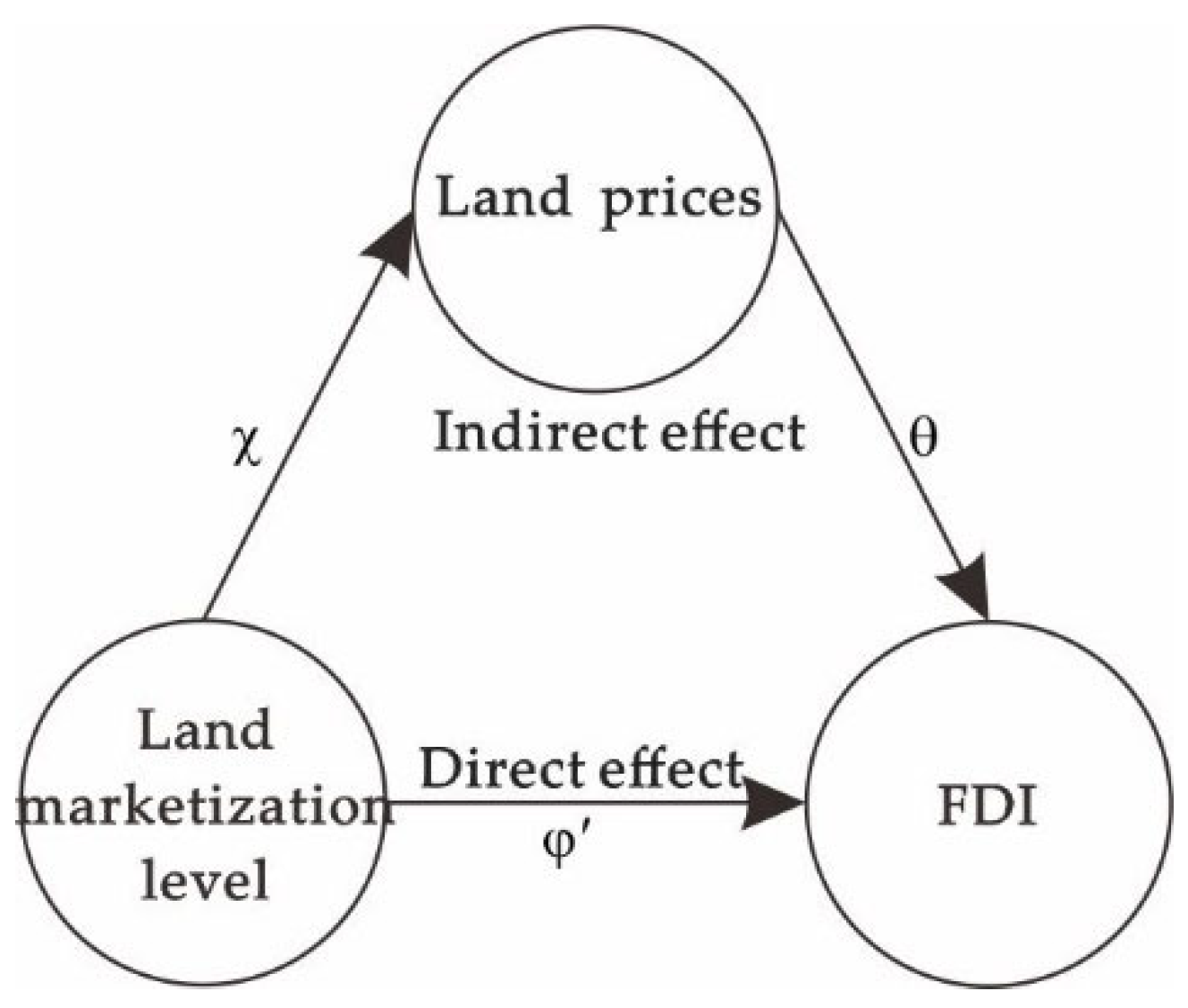
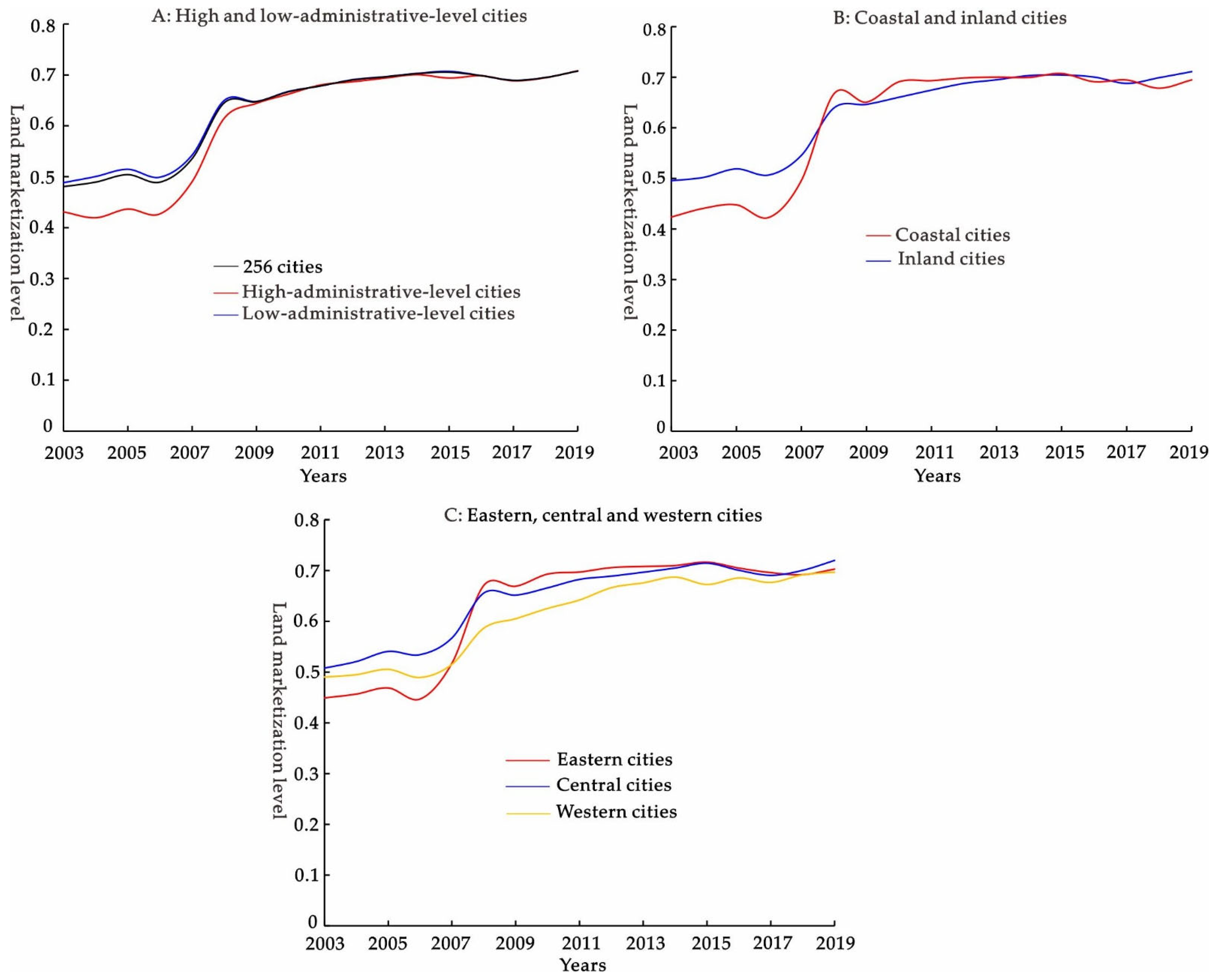
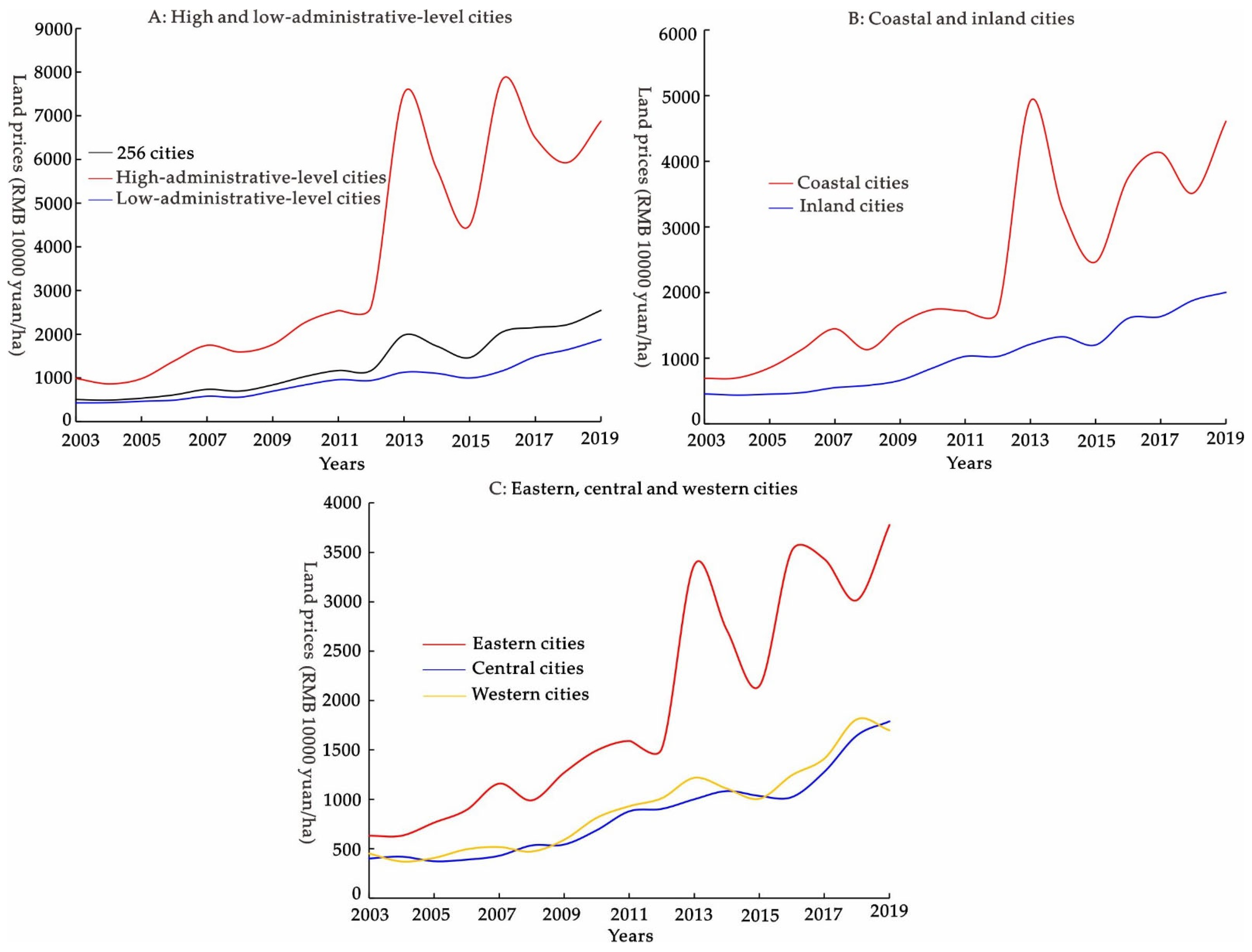
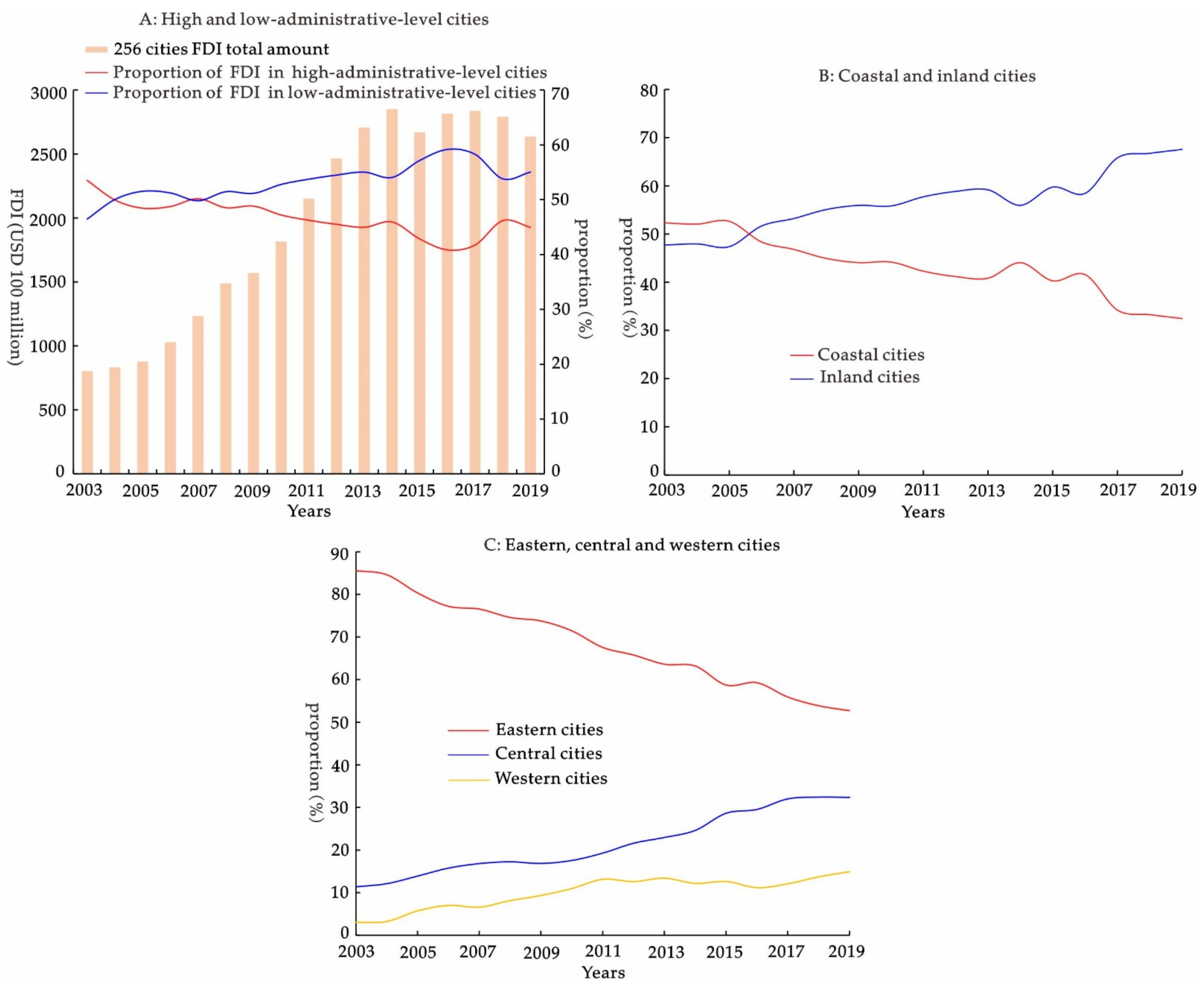
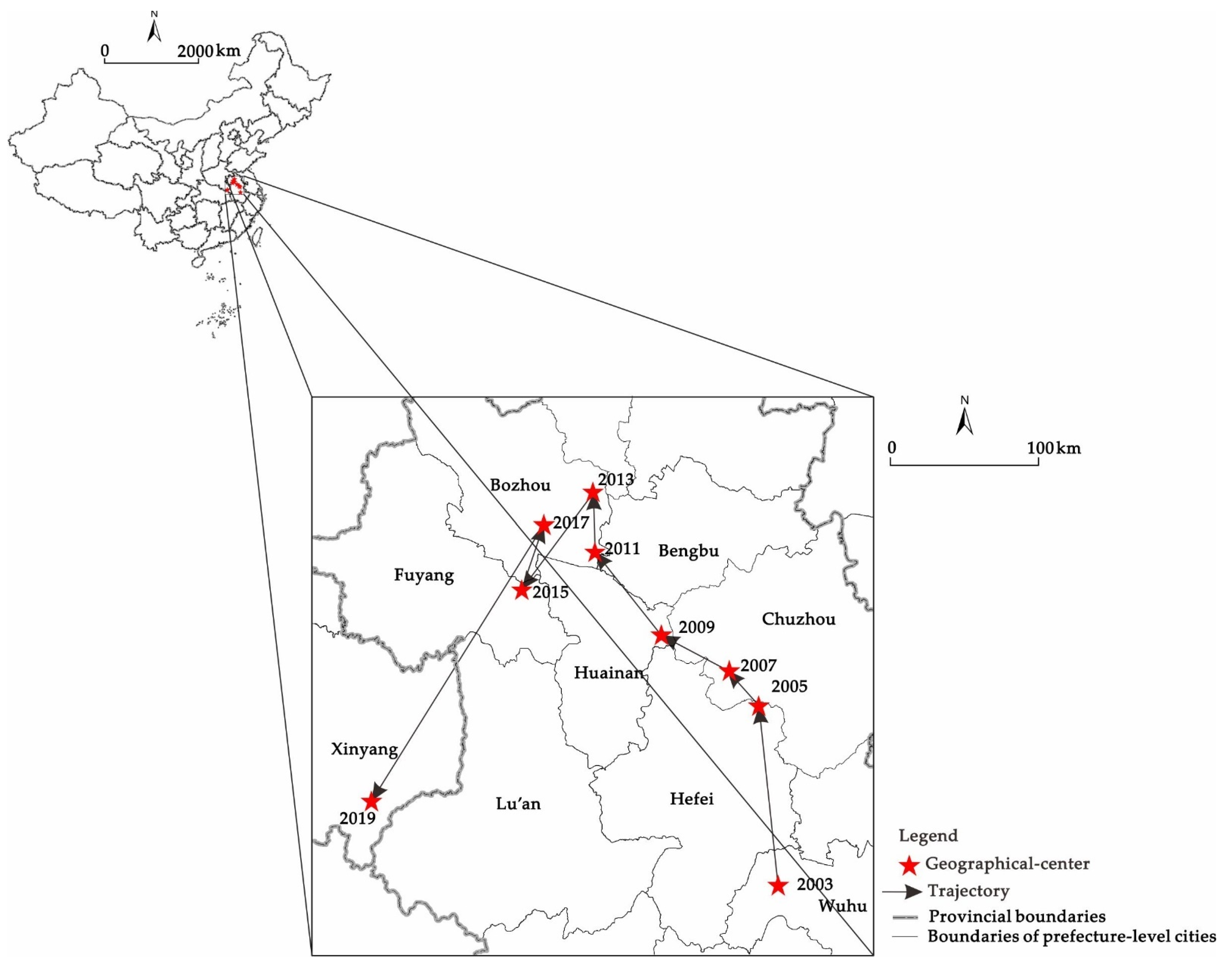
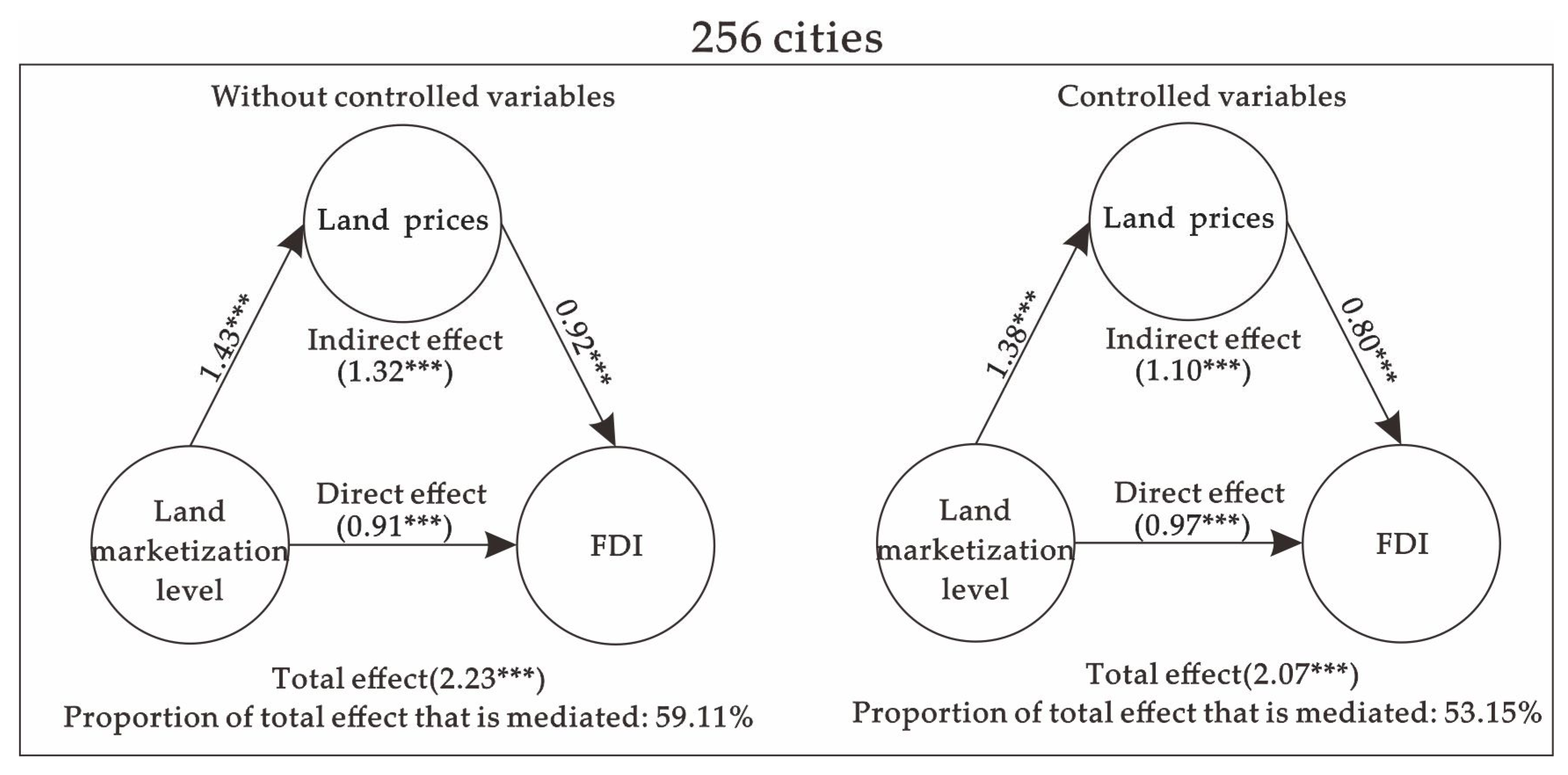
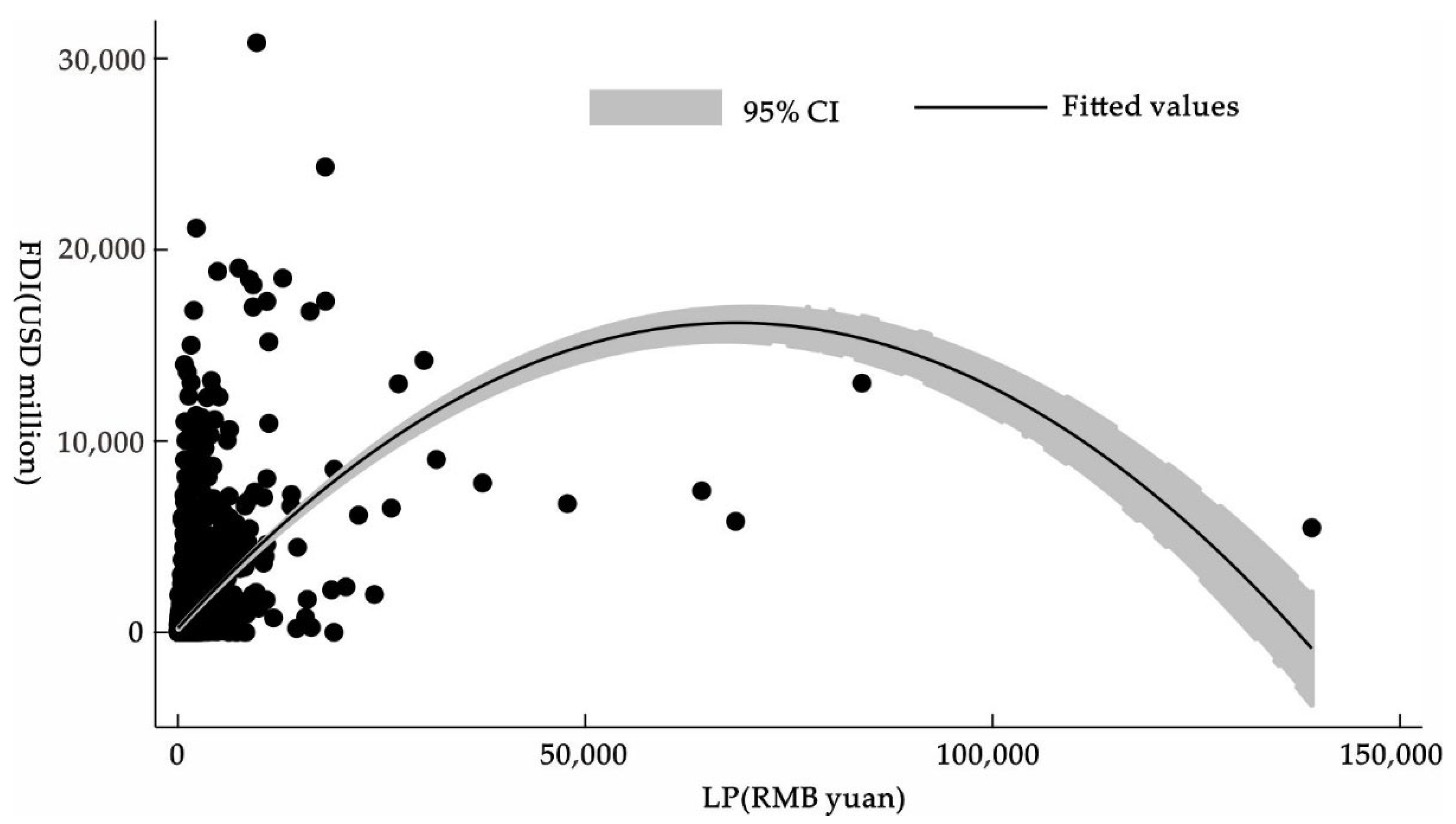
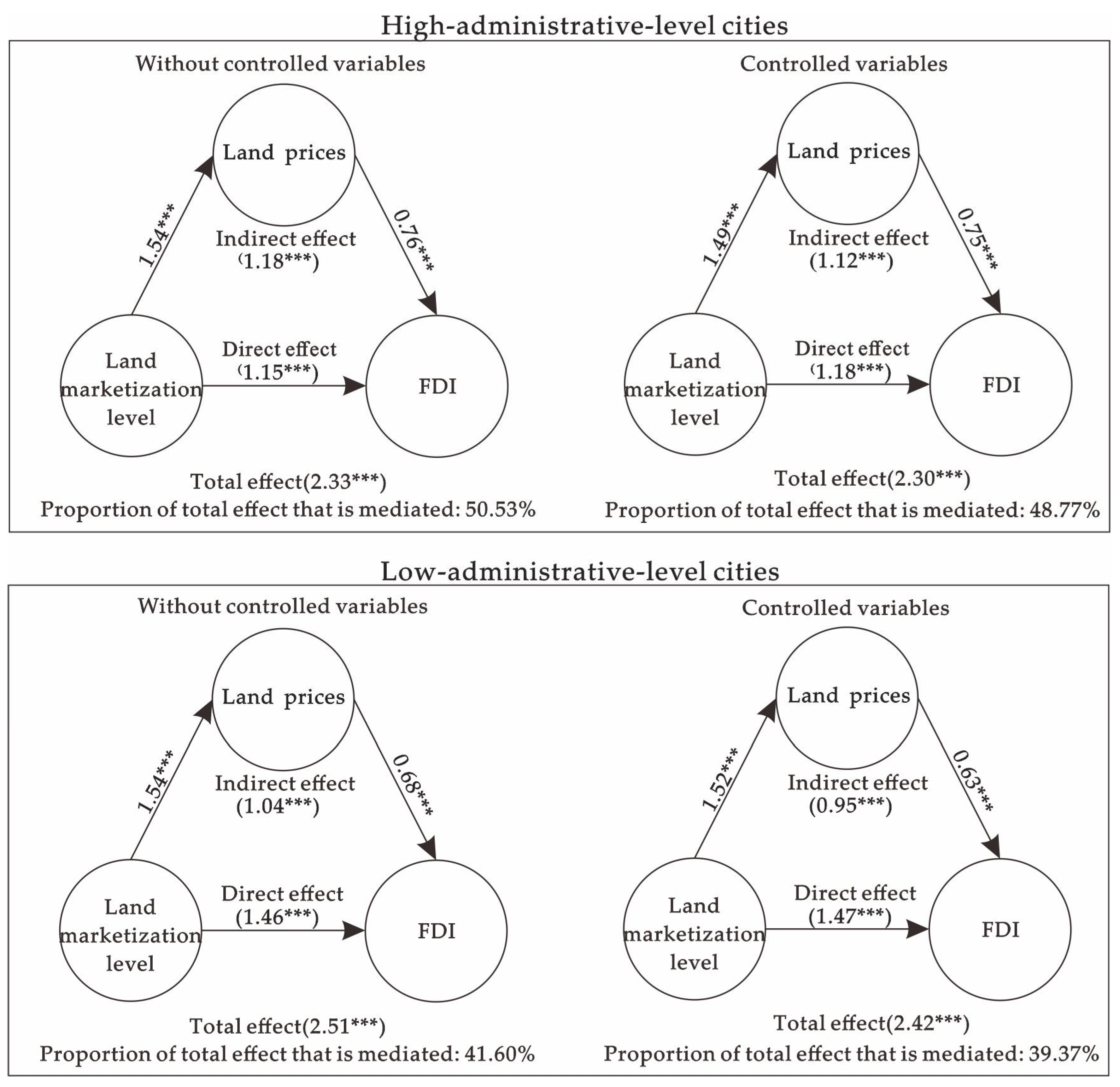

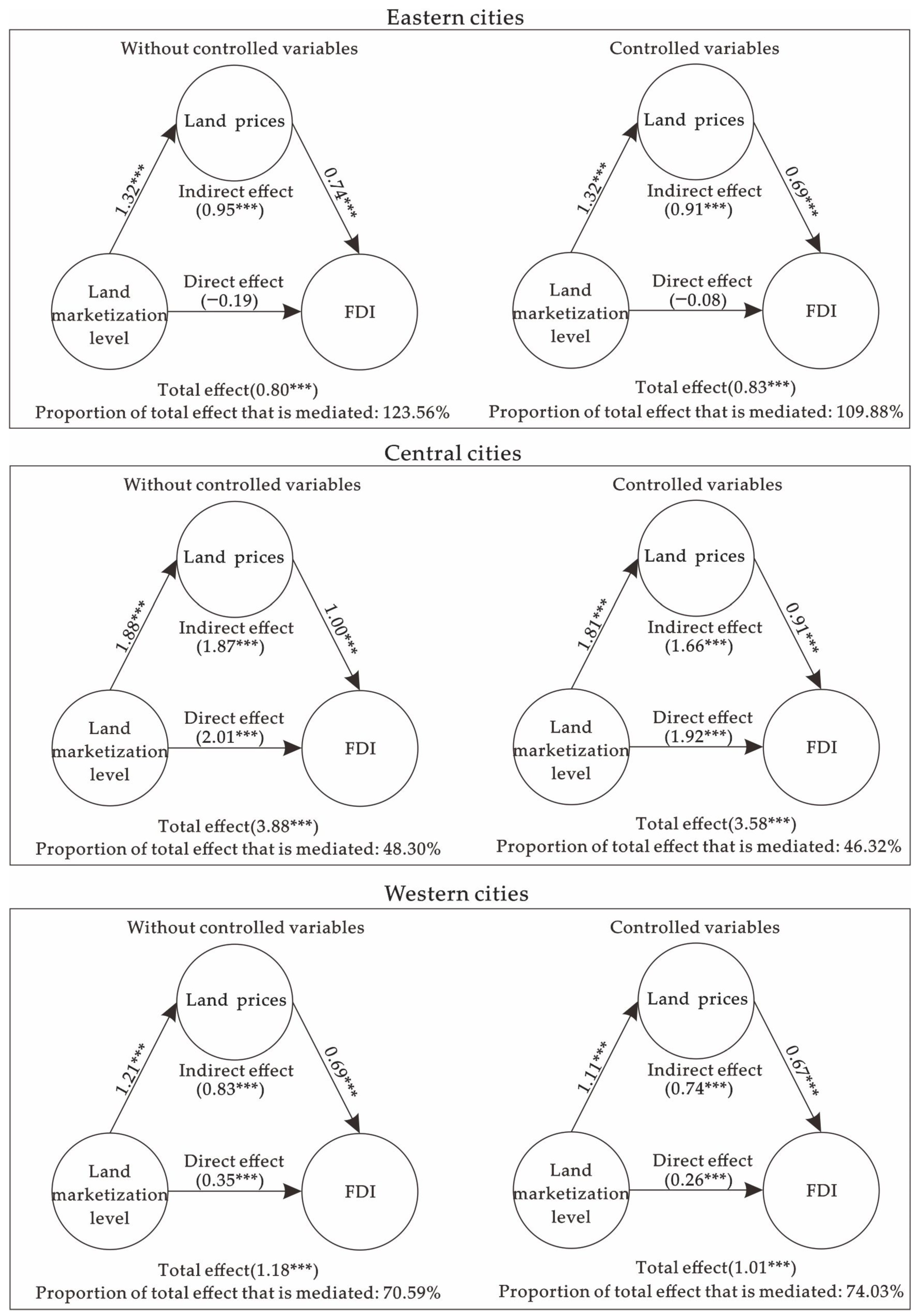
| Variables | Definition | |
|---|---|---|
| Dependent variable: FDI | Foreign direct investment ($10,000) | |
| Key explanatory variables | Land marketization level (LM) | Ratio of the weighted sum of the number of parcels exchanged through the four means of land transfer to the total number of parcels |
| Land prices (LP) | Average land prices of parcels exchanged through the four means of land transfer (¥10,000 yuan/Ha) | |
| Control variables | Labor cost (LC) | Annual average wage of urban workers (RMB yuan) |
| Exchange rate (ER) | Exchange rate of USD to RMB | |
| Market size (MS) | Population size (10,000 persons) | |
| FDI agglomeration (FA) | Sum of FDI from 2002 to year t ($10,000) | |
| Economic specialization (ES) | Entropy of the sector with the largest share of urban employment | |
| Economic diversification (ED) | Reciprocal of the Hirschman–Herfindahl exponent | |
| Infrastructure (MB) | Number of cell phone subscribers per capita (units per 10,000 people) | |
| Variables | 256 Cities | High-Administrative | Low-Administrative | Coastal | Inland | Eastern | Central | Western |
|---|---|---|---|---|---|---|---|---|
| Z Value | ||||||||
| ln (FDI) | −22.85 *** | −5.45 *** | −22.02 *** | −11.72 *** | −21.08 *** | −12.43 *** | −13.22 *** | −16.33 *** |
| LM | −25.68 *** | −9.49 *** | −24.27 *** | −16.10 *** | −21.19 *** | −18.99 *** | −13.01 *** | −13.60 *** |
| ln (LP) | −60.34 *** | −22.59 *** | −57.02 *** | −28.64 *** | −53.13 *** | −38.36 *** | −33.48 *** | −32.78 *** |
| ln (LC) | −54.96 *** | −4.92 *** | −52.86 *** | −31.40 *** | −30.27 *** | −40.04 *** | −23.33 *** | −21.03 *** |
| ER | −77.61 *** | −28.28 *** | −72.27 *** | −35.31 *** | −69.11 *** | −48.51 *** | −47.28 *** | −37.89 *** |
| ln (MS) | −4.98 *** | 3.24 | −9.8 *** | −13.81 *** | 5.54 | −15.75 *** | 3.71 | 2.38 |
| d.ln (MS) | −30.73 *** | −70.81 *** | −47.55 *** | −42.11 *** | ||||
| ES | −34.90 *** | −11.39 *** | −32.77 *** | −9.72 *** | −32.95 *** | −17.26 *** | −8.92 *** | −30.08 *** |
| ED | −10.84 *** | −3.15 *** | −10.66 *** | −4.49 *** | −9.82 *** | −5.50 *** | −5.61 *** | −9.22 *** |
| ln (FA) | −5.08 *** | 0.75 | −5.23 *** | 0.60 | −6.09 *** | 3.29 | −2.28 ** | −9.56 *** |
| d.ln (FA) | −15.41 *** | −14.17 *** | −21.97 *** | |||||
| ln (MB) | −30.80 *** | −15.98 *** | −27.20 *** | −14.12 *** | −29.59 *** | −17.19 *** | −18.25 *** | −22.64 *** |
Publisher’s Note: MDPI stays neutral with regard to jurisdictional claims in published maps and institutional affiliations. |
© 2022 by the authors. Licensee MDPI, Basel, Switzerland. This article is an open access article distributed under the terms and conditions of the Creative Commons Attribution (CC BY) license (https://creativecommons.org/licenses/by/4.0/).
Share and Cite
Jin, W.; Zhou, C. Effect of Land Marketization Level and Land Prices on Foreign Direct Investment in China. Land 2022, 11, 1433. https://doi.org/10.3390/land11091433
Jin W, Zhou C. Effect of Land Marketization Level and Land Prices on Foreign Direct Investment in China. Land. 2022; 11(9):1433. https://doi.org/10.3390/land11091433
Chicago/Turabian StyleJin, Wanfu, and Chunshan Zhou. 2022. "Effect of Land Marketization Level and Land Prices on Foreign Direct Investment in China" Land 11, no. 9: 1433. https://doi.org/10.3390/land11091433
APA StyleJin, W., & Zhou, C. (2022). Effect of Land Marketization Level and Land Prices on Foreign Direct Investment in China. Land, 11(9), 1433. https://doi.org/10.3390/land11091433






